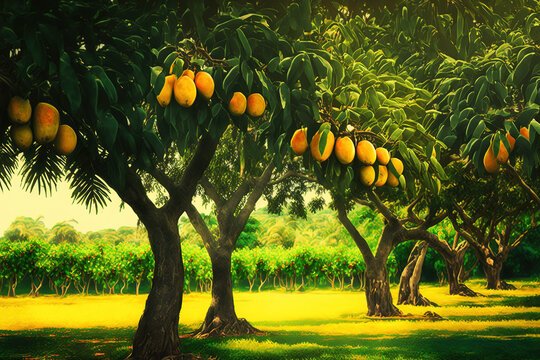
Mango trees thrive in tropical and subtropical climates, where the temperatures do not dip below 40°F (4°C). They require well-drained soil and prefer a pH range of 5.5 to 7.5. These trees need full sun exposure to produce abundant fruits, so it is essential to plant them in an open area with no shading structures
Table of Contents
- Introduction
- Description of Mango Trees
- Cultivation of Mango Trees
- Popular Varieties of Mango Trees
- Health Benefits of Mangoes
- Conclusion
Introduction
Welcome to our exploration of the majestic mango tree! Mango trees, scientifically known as Mangifera indica, are native to South Asia and have been cultivated for thousands of years. These beautiful trees not only provide us with delicious fruits but also offer shade and beauty to the environment. In this article, we will delve into the various aspects of mango trees, from their description and cultivation to the health benefits of their fruits.
Description of Mango Trees
Mango trees are large evergreen trees that can grow up to 100 feet in height, although smaller cultivars are also available. They have a dense and rounded crown, with leaves that are shiny and dark green. The flowers of mango trees are small and white, appearing in large panicles. These trees are known for their distinctive fruit, which is a drupe that varies in size, shape, and color depending on the variety.
Mango trees are known for their long lifespan, with some individuals living for over 300 years. They have a deep taproot system that helps them withstand drought conditions. The wood of the mango tree is highly valued for its strength and durability, making it a popular choice for construction and furniture.
Cultivation of Mango Trees
Mango trees thrive in tropical and subtropical climates, where the temperatures do not dip below 40°F (4°C). They require well-drained soil and prefer a pH range of 5.5 to 7.5. These trees need full sun exposure to produce abundant fruits, so it is essential to plant them in an open area with no shading structures.
When cultivating mango trees, it is crucial to provide regular watering, especially during dry spells. Young trees should be watered frequently to establish a strong root system. As the tree matures, it becomes more drought-tolerant and requires less water. However, during the fruiting season, adequate irrigation is necessary to ensure a good harvest.
Pruning is an essential practice in mango tree cultivation. It helps maintain the shape and size of the tree, promotes better airflow, and facilitates easier fruit picking. Pruning should be done during the dormant season to minimize stress on the tree.
Popular Varieties of Mango Trees
Mango trees are cultivated in various regions worldwide, leading to the development of numerous mango varieties. Here are some popular varieties:
| Variety | Origin | Description |
|---|---|---|
| Alphonso | India | Known for its rich flavor and smooth texture, Alphonso is often referred to as the "King of Mangoes." |
| Tommy Atkins | United States | A popular commercial variety, Tommy Atkins mangoes have a mild and sweet taste with a colorful appearance. |
| Kent | United States | With a sweet and juicy flesh, Kent mangoes are widely consumed both fresh and in various culinary preparations. |
| Ataulfo | Mexico | Also known as Champagne mango, Ataulfo mangoes are small-sized with a creamy texture and honey-like sweetness. |
Health Benefits of Mangoes
Mangoes not only tantalize our taste buds but also offer a wide range of health benefits. Here are some notable advantages of consuming mangoes:
- Nutrient-rich: Mangoes are packed with essential vitamins and minerals, including vitamin C, vitamin A, folate, and potassium.
- Boosts immunity: The high vitamin C content in mangoes helps strengthen the immune system and fight off infections.
- Improves digestion: Mangoes contain dietary fiber, which aids digestion and prevents constipation.
- Supports eye health: The vitamin A and antioxidants present in mangoes contribute to good vision and overall eye health.
- May reduce cancer risk: Some studies suggest that the compounds found in mangoes may have anticancer properties.
Conclusion
Mango trees are not only a source of delectable fruits but also a symbol of beauty and abundance. From their towering presence to their valuable wood and nutritious fruits, mango trees hold a special place in our world. Whether you're enjoying a juicy slice of mango or simply appreciating the shade they provide on a sunny day, these magnificent trees deserve our admiration. So, next time you encounter a mango tree, take a moment to marvel at its grandeur and appreciate all the wonders it brings.



0 Comments